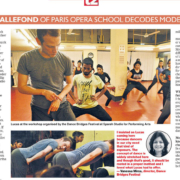Lucas Viallefond of Paris Opera School decodes Modern Dance
We were delighted to present a modern dance workshop with French artist, Lucas Viallefond, a modern dancer and a teacher at the Paris Opera School. http://
We are grateful to the support by Sparsh Studio for Performing Arts, Alliance Francaise du Bengale and Buoyant Performing Arts in partnering with us for this event.
Read an artist interview and coverage of the workshop in The Telegraph t2 here.
Lucas Viallefond, a French modern dancer and teacher at the prestigious Paris Opera School, made a quick stop in the city on January 27 to teach a workshop as part of the Dance Bridges Festival. A dancer trained at the Conservatoire de Paris and Folkwang University of the Arts, Lucas has travelled to about 16 countries, teaching and dancing. t2 caught up with Lucas, who specialises in the Jooss-Leeder method, developed by Hans Zullig and Jean Cebron, at Sparsh Studio for Performing Arts…
What is the basic difference between contemporary dance and modern dance?
According to dance timelines, modern dance was created after ballet in the 1990s, as a response against ballet. In ballet, you have to have a perfect body and the perfect lines. People who didn’t have that but wanted to be dancers could not. If ballet dancers sported tight buns, modern dancers went with their hair flowing free and wild. If ballet dancers wore shoes, modern dancers went barefoot. If ballet dancers were in tutus, modern dancers chose to go almost naked. This was the beginning of modern dance. Isadora Duncan and Martha Graham in the US and Mary Wigman in Germany began to create a technique and this is modern dance, as it was really modern for the times. I can speak of contemporary dance in the French context. French people were tired of modern dance and created their version of contemporary dance. The basis of contemporary dance is idea —when you have ideas, you put it to form. It can be anything. It’s impossible to describe French contemporary dance. Each choreographer has a very specific way of moving. It can be someone rolling on the floor for hours or someone just performing striptease with eggs on their head. It’s much more of ideas than the body moving. Modern dance is almost set — when you see a piece by Martha Graham, you know it’s her work. I am more into body than the head, so it’s that kind of a difference for me.
What made you take up dance?
I live in a very small street in Brittany in the west of France where there is nothing. In France, we have a musical day that is celebrated on June 21 every year, the first day of summer for us. There are people going out to make music everywhere. I once drove with my mother to another village where I saw a dance performance by a dance teacher and I saw two guys from my college take part in it. I was 13 and I knew I could do better. But I really took up dance because I needed to express myself as I wasn’t very good at speaking to people. So first, I practised a lot of gymnastics and then I learnt a lot of music. But that wasn’t enough for my body. I had to express more and then I began dancing. My dance teacher forced me to learn ballet; she sent me to Paris and I got into the Conservatoire de Paris, where I learnt for five years. In my third year, I met Pina Bausch and got invited to Germany. I quit the school three years later and started teaching a lot. I came back to France and began dancing for a lot of companies and teaching at the same time. Then I was invited to Taiwan, from where I taught all over Asia. I think you can’t be a very good dancer without teaching. While teaching people, I corrected myself too.
What is the Jooss-Leeder method?
Based on Rudolf Laban’s principle of movement, the precise consciousness of one’s body in space and its dynamics form the basis of this approach. It’s not a technique, but a method. It’s based on the point of view of dance that is based on the science of quality and the science of space. You can divide the space into different points and then you have millions of ways of going about it. I can do direct and indirect movements or put a lot of strength or use light and quick movements, coming from or outside the body. My teaching is based on all these different qualities in specific points of the space. And it’s not a style but a method. I give keys to students on how to use their body and then they do what they want to do with that. So when I teach, I don’t like to choreograph because I don’t want them to dance like me because the point of view of a dancer is in him/her being unique.
What do you think about the future of modern dance?
I think modern dance is always evolving, so it’s nice to see that some people are trying to make it more creative. For me, the most interesting dancers are the ones who dance with feelings. I don’t like to see high legs and many turns. The one who dances with an intention makes the difference between the dancer and the artiste.
Modern dance is fairly less known. How can that be changed?
In order to make people more interested in modern dance, there should be more workshops with good teachers who give a lot in the class and try to help the dancers to be better.
Check out a video interview with the artist here.

